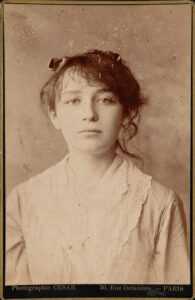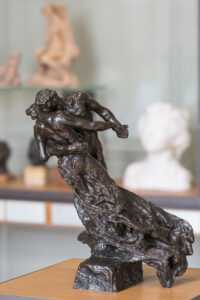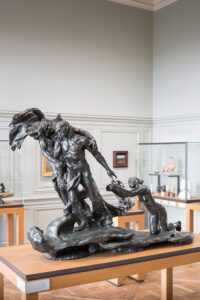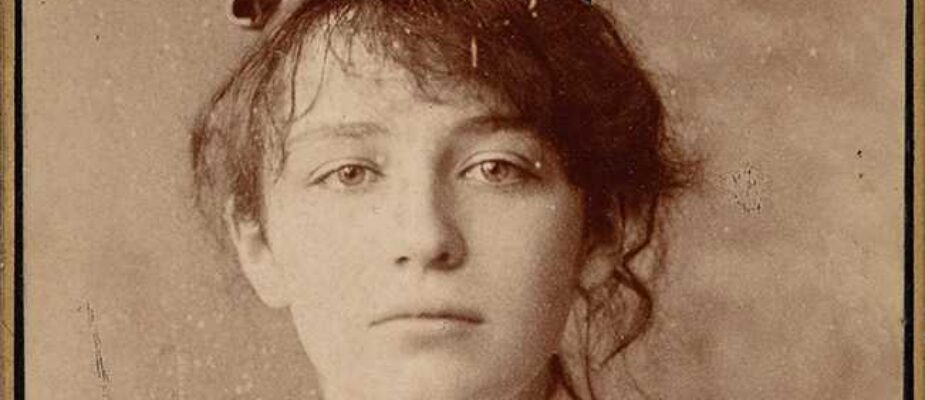By Kristen Pignuolo, Curatorial Assistant
“For a man, being a sculptor is a constant challenge to common sense; for an isolated woman, especially one with my sister’s character, it is a pure impossibility.” -Paul Claudel1

In 1881, 17-year-old Camille Claudel arrived with her family in Paris from a small town in the Champagne region of France. A talented and intelligent child, Claudel pursued sculpting from a young age. One work, a sculpture of David and Goliath made when Claudel was 13, attracted the attention of sculptor Alfred Boucher. While there were provincial art schools that taught girls and young women how to draw, none of them permitted women access to nude models due to issues of “propriety.” However, the nude form was the standard of all art and a requirement for serious artists to render competently. Boucher knew that for his young protégée to flourish, studying in Paris was a necessity.
For women hoping to pursue artistic study, they would need to be tutored by an artist, attend an academy that permitted female students (though there are instances, such as the Académie Julian, where female students were charged double the fees male students were charged2), or attend an atelier féminin, a women-only studio where one could study nude models without worries about propriety. Claudel shared a studio with several other women sculptors and received free weekly lessons from Alfred Boucher. In 1882, about to embark on a trip to Italy, Boucher asked a friend and fellow sculptor, Auguste Rodin, to supervise his students while he was gone.
Rodin quickly recognized Claudel’s artistic talent3 and invited her to join his studio as an assistant in 1883, assisting with two commissions: The Gates of Hell and The Burghers of Calais. Around this time Claudel and Rodin began a passionate relationship. However, Rodin had a companion of twenty years, Rose Beuret, with whom he had a child (a son that Rodin would never legally recognize as his). Claudel was jealous of Rose and resentful of Rodin’s refusal to leave her.
While working in Rodin’s studio, Claudel worked on her own pieces and regularly exhibited them in the 1880s and early 1890s. One of her most acclaimed works, The Waltz, was presented at the 1893 Salon National des Beaux-Arts. While some found the work’s sensuality distasteful for a woman artist, it still garnered critical praise. Art critic Octave Mirbeau stated that Claudel “daringly took on what may be the most difficult to convey for a sculptor: a dance movement. So that it does not become crude, so that it does not remain frozen in stone, infinite art is required. Mademoiselle Claudel had this art.”4

As Rodin and Claudel grew apart around 1892, she rented her own studio space and left Rodin’s atelier to distance herself as an artist from Rodin’s orbit. However, after some time apart, the two struck up a renewed friendship with Rodin promoting Claudel’s work. This period became Claudel’s most prolific with one particular focus, a commission from the Ministry of Fine Arts called The Age of Maturity. The work took several years to complete, and Claudel exhibited it along with several other works in May 1899 at the Salon. In The Age of Maturity, the figure of Youth reaches out to a man being shepherded away from her by Old Age. To those familiar with Claudel and her history with Rodin, the parallels between their relationship and Rodin’s relationship with Rose Beuret were obvious. Upon seeing The Age of Maturity, Rodin reacted with shock and anger. He valued his privacy and saw the work as a betrayal. There is speculation that Rodin had a hand in having the Ministry of Fine Arts cancel their commission in retaliation. The work was also rejected at the 1900 Universal Exhibition, and Claudel withdrew all her other sculptures from the Exhibition out of spite.

After this debacle, Claudel became reclusive and increasingly paranoid that Rodin was slandering her and hindering her career. In reality, Rodin went to increasingly convoluted lengths to give Claudel money, sending intermediaries to purchase her work. At one point, Claudel confided in Henri Asselin, a friend of Eugène Blot (Claudel’s art dealer), that she believed Rodin sent two of his models to assassinate her5 so Rodin could steal her work. While Claudel still made clay and plaster pieces during this time, none of them exist today. Claudel would frequently destroy her work and have it buried, typically after a crisis.
In July 1913, Claudel’s younger brother Paul had her committed to a mental hospital. Despite medical reports indicating a significant improvement in her mental state in 1919,6 she was wrongfully declared dead in 1920 and remained institutionalized until her death in 1943.7
1 Paul Claudel, Oeuvres en prose (Paris: Gallimard, 1965), 280.
2 Odile Ayral-Clause, Camille Claudel: A Life (New York: Harry N. Abrams, 2002), 27.
3 Ayral-Clause, Camille Claudel: A Life, 50.
4 Lucien Bourdeau, “Description d’oeuvres exposées aux Salons de 1893,” Revue encyclopédique Larousse (1893), 823.
5 Ruth Butler, Rodin: The Shape of Genius (New Haven: Yale University Press, 1993), 282.
6 Ayral-Clause, Camille Claudel: A Life, 217.
7 Ayral-Clause, Camille Claudel: A Life. 57.










